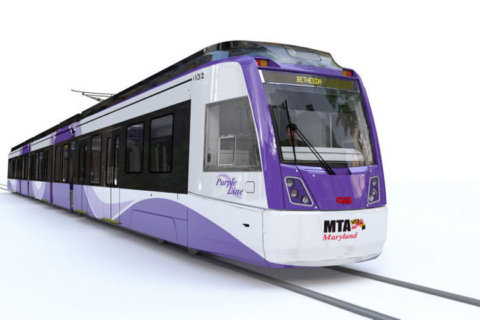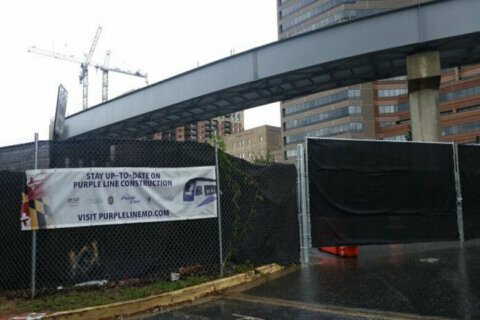Maryland transit officials pledged to get the Purple Line done despite the legal dispute between the state and contractors.
There are three possibilities for finishing the project: The state could enter into a settlement with the Purple Line Transit Constructors, who have been involved in a legal dispute over unpaid cost overruns; the state could also take on the project itself, hiring contractors as needed, or the state could rebid a public-private partnership.
Kevin Quinn, administrator for the Maryland Transit Administration, told the Montgomery County Council on Tuesday, “We absolutely remain open to a fair and reasonable settlement” but added that he couldn’t say much more while legal discussions are underway.
Council member Andrew Friedson, whose district includes Bethesda, told Quinn, “I am hoping that the future bids are not kind to the concessionaire.” He added, “Commitments made should be commitments kept.”
Friedson also voiced concern over the current state of the project, saying that short-term pain is expected to provide long-term gain, but in the meantime, “This construction has taken away pedestrian access, has taken away trail access” in areas where construction has begun.
Friedson also urged transit officials to make information on cost and completion public. “This is too important a project, and we have too much invested in this project, for the public not to know exactly what the options are,” he said.
Council President Sidney Katz said the dispute with the concessionaires in the Purple Line’s public-private partnership has implications that go beyond the transit project.
“We are concerned about the whole P3 (public-private partnership) situation for 270 and 495,” Katz said, referring to the proposal to add toll lanes to segments of the Capital Beltway and Interstate 270.
‘Transformational’
That highway expansion project has a projected price tag of more than $9 billion and would, according to Gov. Larry Hogan, be “transformational” in providing congestion relief in the region.
Quinn told the council members, “Over the next 30 days, we will have a better understanding of the construction work that will continue or that may be delayed” on the Purple Line.
After the 30-day period, it would take another four to six months to get contracts in place “to really nail down what the long-term project delivery strategy is going to be,” Quinn said.
In the coming weeks, Quinn and Matt Pollack, the Maryland Transit Administration’s executive director for the Purple Line project, said that state officials would be walking along the 16-mile light rail route to determine what work could continue as the legal issues are sorted out.
Pollack told council members, “We’re taking actions to keep the Purple Line project moving forward.”
He ticked off a few of the items that residents along the route could see getting worked on. “There’s lots of walls along the alignment,” and completion of the walls could get underway, he said.
“And we have a large amount of off-site equipment” being manufactured and tested, Pollack added.
‘They were abandoning the project’
Council member Will Jawando asked why the state wasn’t further ahead in making the transition to new construction plans as a result of the litigation.
Quinn said in response, “We had a very different take on it … that they were abandoning the project. Our point was that to participate in transition plan meetings would be to participate in I think what we felt was an inappropriate abandonment of the project.”
Council member Nancy Navarro told Quinn and Pollack, “It’s so disheartening to be in this position” with a project such as the Purple Line subject to more delays.
Noting that the Purple Line would tie Bethesda to New Carrollton, Council member Hans Riemer said the project “is essential for the future of this county.”
Several council members repeated their wish for more vocal support for the light rail project from Hogan.
That included Gabe Albornoz, who told the MTA representatives, “I appreciate the optimistic assurance that this project will move forward by the staff most directly associated with this project,” but he said he thought it was critical to hear the same level of commitment from Hogan.
Alboronoz said, “There are organizations and communities who have been opposed to this project that smell blood in the water and are hoping that this will fall through,” and said for that reason, it was important to get support from the governor.
“I think the governor has very much stepped up in support of this project. He was an advocate for getting the federal funding,” said Quinn, who added that the state had made “significant” investments in the Purple Line.
Later Tuesday, Mike Ricci, a spokesman from Hogan’s office, said in response to the county council members’ call for the governor to voice additional support for the Purple Line:
There’s no question that the Purple Line is an important project for the state and the region. It creates jobs, connects communities and improves our infrastructure. The governor fully supports Secretary Slater’s efforts to get the project done and protect taxpayers while ensuring we have a partner that also has the best interests of Marylanders in mind.
Transportation Secretary Greg Slater was not able to attend the meeting, though he had been scheduled to attend.








